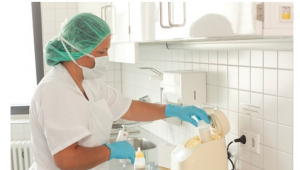
© Quirin Leppert/EFCNI
Human Milk Bank (HMB) services have been impacted by the global COVID-19 pandemic. To better understand the impact, a Virtual Communication Network (VCN) was formed to collect data and experiences from HMBs across 35 countries. Every year approx. 800,000 infants receive donor human milk (DHM) worldwide. However, seven pandemic-related vulnerabilities to HMB service provision were identified.
The World Health Organization (WHO) recommends donor human milk from milk banks (HMB) as the next best alternative for low birthweight or vulnerable infants, when mother’s own milk (MOM) is not available. However, milk banks have been facing multiple challenges during the pandemic, mainly related to external forces such as donor recruitment or logistics. As a response to this situation, a Virtual Collaborative Network of 80 HMB was created to estimate the scale of HMB services globally and, most importantly, recognise and mitigate the COVID-19 pandemic-related obstacles for infants in need of DHM. The interdisciplinary group of experts was formed in March 2020 to collect evidence through online platforms.
The results indicate that approximately 806,000 babies in hospitals receive DHM annually worldwide and that there has been even more demand in 2020 due to implemented breastfeeding policies due to COVID-19. Sadly, the analysis noted a reduction in potential milk donors, possibly resulting from fear about leaving the house during the pandemic and implemented restrictions. Some donors have also reported concerns that they may transmit SARS-CoV-2 via their donated milk (however, recent data confirmed that there is no evidence of such transmission via breastmilk). Furthermore, basic transport infrastructure was closed in some areas, preventing donors from reaching “milk drop” sites. Lacking international guidelines have furthermore contributed to mixed messages and confusion. Overall, seven pandemic-related vulnerabilities in service provision were identified, including maintaining sufficient donors, transport logistics, safe handling, and contingency planning. Mitigations are proposed.
As a result of the study, the VCN has also created guidance around safe handling and processing of human milk in the context of COVID-19. Some of the recommendations include the heat-caused inactivation of the SARS virus and general hygiene rules for staff and donors. Before any face-to-face contact with the HMB team, the digital screening of donors should be considered as good practice. Additionally, databases that enable rapid (but secure) communication with milk donors should be maintained by individual HMBs to ensure data safety. Social media and other systems to improve communication and networking between HMBs are crucial for mutual-learning processes and experience-sharing related to COVID-19 safety. Lastly, the VCN recommends the HMBs to consider contingency plans and to welcome innovation for future challenges.
Paper available at: Maternal & Child Nutrition
Full list of authors: Natalie Shenker, Marta Staff, Amy Vickers, Joao Aprigio, Satish Tiwari, Sushma Nangia, Ruchika Chugh Sachdeva, Vanessa Clifford, Anna Coutsoudis, Penny Reimers, Kiersten Israel-Ballard, Kimberly Mansen, Radmila Mileusnic-Milenovic, Aleksandra Wesolowska, Johannes B. van Goudoever, Mohammadbagher Hosseini, Daniel Klotz, Anne Hagen Grøvslien, Gillian Weaver, Virtual Collaborative Network of Milk Banks and Associations

